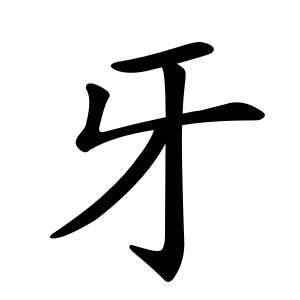牙
- molar;
- cheek tooth, wisdom tooth;
Etymology
It is a pictograph representing two teeth interlocking vertically. Also known as Aseong (牙城), in ancient China, generals would place ivory-tipped flags in the center of their fortress to display their authority and dignity. This flag was called "Agi," from which the term "Aseong" (literally "Ivory Fortress") originated.
Even today in Korea, expressions like "to break down the Aseong" or "to surpass the Aseong" are commonly used.
The meaning is "molar," but molars are actually written as 臼齒 (gu-chi) in Chinese characters, and the term "ivory" is sometimes used in words unrelated to molars.
Words that derived from 牙
牙
어금니
아
eogeumni
a
Kangxi radical:92
Strokes:4
Unicode:U+7259
Cangjie input:
- 一女木竹 (MVDH)
Composition:
- ⿹⿻ 𠃋 丁 丿
